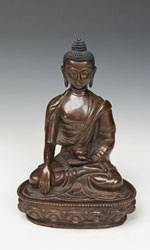 |
|
| Nepalese Akshobya Buddha sculpture |
|
As time passed, Buddhism adapted to new cultures. At the beginning of the first century A.D.
Buddhist
doctrine underwent a change from a simple philosophy of life into a set of religious doctrines with
Buddha
transformed into a deity on the same level as
Hindu
gods. It is thought, however, Buddha never projected himself as a divine entity or master, demanding from those who followed him only personal attainment through meditation and reflection, the object being to liberate oneself from the cycle of rebirths to reach nirvana.
Buddhist missionaries brought their doctrines very early to other countries. Ultimately, the effigies representing the Buddha assumed a local character, and the faces of the deities became influenced by local ethnic types and the aesthetic canons of the regions. In
Nepal
, the depictions of the Buddha became almost lifelike with refined features, and the “attitudes” became meditative in nature. Depictions of Buddha in Nepal attempted to convey a single, simple truth conveyed in the hand positions (mudras), leg positions (asanas), and serene, knowing faces. Most Nepalese Buddhas are depicted in the seated position with a leg position, or Asana called “Padmasana,” the lotus position, which is the meditative position. The mudras may vary.
In Tibetan Buddhism there are five Buddhas known as the
Dhyani
Buddhas. All represent Buddhas in meditation and are said to emanate from Adibuddha, the original Buddha who is regarded as being without beginning or end. The Dhyani Buddhas are not separate gods, but instead, represent abstract aspects of Buddha hood. The word Dhyani is derived from the Sanskrit dhyana, meaning meditation. These Buddhas are also called Jinas (victors or conquerors) and are considered to be great healers of the mind and soul.
The Dhyani Buddha Akshobya is known as “The Unshakable One,” or sometimes “The Unmovable Diamond” Buddha. Akshobya transforms ignorance and stupidity into all pervading awareness and counteracts anger and hatred. The mudra associated with Akshobya depicts the right arm pendant over the right knee. The hand is turned palm inward and all the fingers extend downward with a finger touching the lotus throne. The left hand lies on the lap with palm upward holding a begging bowl, which is not always shown. Together, this mudra is called Bhumisparsa, which means, “taking the earth as witness” to Buddha’s truth. It is the gesture of Akshobya. The begging bowl is said to contain the elixir of life.
Virtually all Nepalese
Buddhas
and statues are created using the lost wax process. In this process a meltable substance (usually hard wax) is carved as the original sculpture. Around the original a mold is created, usually composed of clay and straw. After the mold hardens the molten metal is poured inside where it displaces the wax. After the metal hardens the mold is broken revealing the statue. The lost wax process can only produce one-of-a-kind objects since both the original and mold are destroyed in the production process. Today, it is widely recognized that the finest lost wax process castings come from Nepal. The artistry, level of detail and finesse with which they are created place them in a category all by themselves.
Download this Article: Akshobya Nepalese Buddha.pdf
